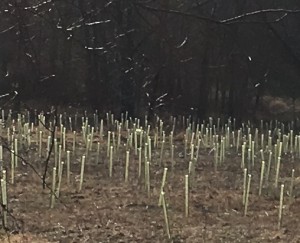
Removed Tree Tubes (December 2024)
Hello, fellow lovers of all things green. Over the weekend, we stumbled upon a stack of plastic tubing while walking the Paulinskill Rail Trail. I was delighted to see the tubes, as the trees they were protecting looked like they had outgrown them. This inspired revisiting when I first learned about the Preservation of the Paulinskill River in 2016.
A friend stumped me when he asked what the plastic “thingies” were along routes 80 and 94. They looked like tree tubes, but you couldn’t see any signs of trees. I thought they may be part of a Superfund cleanup to vent toxic gas. In years past, industry waste was routinely dumped along rivers or open spaces. Congress initiated the Superfund program in 1980, and tons of cleanup is ongoing.
The Tubes Protect Saplings
I contacted my go-to mystery solver of all things in nature, Dennis Briede, Stewardship Manager of the Land Conservancy in New Jersey, who confirmed they were tree tubes. The Nature Conservancy received a large grant from the Dodge Foundation to help restore the open bottomlands next to the Paulinskill River.
“There are tiny trees inside the tubes to protect them from rodents,” Dennis said. Mice and moles feed on the bark, especially in winter, and can kill a tree. And, of course, deer browse and deer rub can, too.
I asked if he knew what species they planted along the low-lying areas that often flood. Mr. Speedy contacted The Nature Conservancy to learn the lineup that we could also grow in our yards in the regions that are moist or sometimes flood.
The Lineup of Native Trees you can plant too:

Growing Trees along Paulinksill River (2024)
Yellow Birch (Betula alleghaniensis) is a native species with a bright gold fall color. While rarely seen at nurseries, it is worth scouting for the beautiful tree with yellow-brown or red-brown bark. Wintergreen oil is distilled from Yellow Birch, which is likely why deer favor it.
They also planted River Birch (Betula nigra), which I often recommend for its magnificent salmon-colored peeling bark, glorious yellow fall color, and deer resistance.
There’s Pin Oak (Quercus palustris), one of the fastest-growing oaks, and Swamp White Oak (Quercus bicolor), which tolerates wet soil and occasional flooding, as does Ironwood also known as American Hornbeam (Carpinus caroliliana).
Deer will stay clear of the Black Willow in the mix (Salix nigra). And the Red Maples (Acer rubrum) sport brilliant red foliage come fall. Then comes the glossy star-shaped leaves of American Sweetgum (Liquidambar styraciflua) that turn into a glorious mix of fall colors. Of course, American Sycamore, also known as Planetree (Platanus occidentalis), is in the lineup, known for handling wet feet and striking camouflaged mottled trunks.
The Nature Conservancy’s Update:
The Nature Conservancy’s website reports planting over 37,500 trees, many dug in by volunteers, to reforest ten miles of the floodplains. The trees will help filter water, absorb floodwater, lessen sediment runoff, and shade the riverbank, cooling the water for fish.
Along with other activities such as removing dams, “more than 2,000 of them—disrupt fish migration and water flow, altering the health of entire river systems,” the conservancy is working with “the New Jersey Department of Environmental Protection, Sussex County Municipal Utilities Authority – Wallkill River Watershed Management Group, along with local organizations and private and public supporters, to revitalize the more than 40 miles of the Paulinskill.”

Red Maple / Acer rubrum
Photo: Arbor Day Foundation
They are measuring populations of dragonflies, their shorter, thinner lookalikes, damselflies, and freshwater mussels to establish a baseline for monitoring outcomes and perhaps modifying restoration projects over time. I adore their philosophy that “together, we can secure clean water for all people without sacrificing the environment.”
And now, the baby trees are outgrowing their tubes—a beautiful thing.
Garden dilemmas? AskMaryStone@gmail.com and your favorite Podcast App.
There’s more to the story in the Garden Dilemmas Podcast:
Related Posts to Enjoy:
Halloween History & Sycamore Ghosts
Birch Tree’s Strength in Flexibility






I live in Lafayette and it is great to see the trees growing, but when the heck is someone going to take those plastic tree protectors off. I thought they did that after a couple of years, but they haven’t and look like ugly trash left in the woods.
Hi Karyn, It was 8 years from when they installed the trees (in 2018) to when they removed the tubes here in Blairstown, NJ (Fall of 2024). The trees look happy! Hopefully, they’ll get to your neck of the woods soon. Thanks for reading my post, Mary Stone